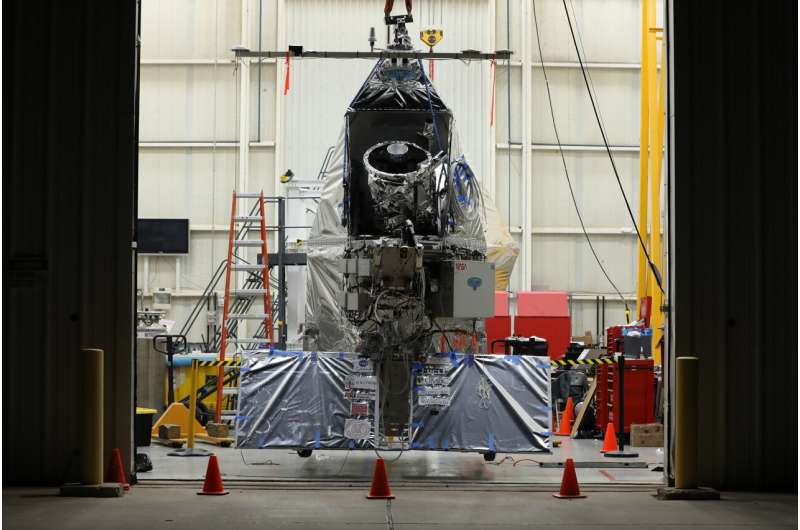
EXCITE (EXoplanet Climate Infrared TElescope) hangs from the ceiling of the Columbia Scientific Balloon Facility in Fort Sumner, New Mexico. The mission team practiced preflight observations by looking out the hangar doors at night. Image credit: NASA/Jeanette Kazmierczak
Scientists and engineers are ready to fly an infrared mission called EXCITE (EXoplanet Climate Infrared TElescope) to the edge of space.
EXCITE is designed to study atmospheres around exoplanets, or worlds outside our solar system, during long-duration scientific balloon flights above the Arctic Circle. But first, it must complete a test flight during NASA’s science balloon campaign in fall 2024 from Fort Sumner, New Mexico.
“EXCITE can give us a three-dimensional picture of a planet’s atmosphere and temperature by collecting data throughout the time the planet orbits its star,” said Peter Nagler, the mission’s principal investigator at NASA’s Goddard Space Flight Center in Greenbelt, Maryland.
“So far, only a few measurements of this kind have been made. They require a very stable telescope capable of tracking a planet for several days.”
EXCITE will study hot Jupiters, giant gas planets that orbit every one to two days and have temperatures of several thousand degrees. The worlds are tidally locked, meaning the same side always faces the star.
The telescope will observe how heat is distributed across the planet, from the scorching hot hemisphere facing the star to the relatively cooler night side.
It also measures how molecules in a planet’s atmosphere absorb and emit light throughout its orbit, a process called phase-resolved spectroscopy. This data can reveal not only the presence of compounds such as water, methane, carbon dioxide and others, but also how they circulate globally as the planet orbits its star.
NASA’s Hubble, James Webb and Spitzer space telescopes have together collected a handful of such measurements.
In 2014, for example, Hubble and Spitzer observed an exoplanet called WASP-43 b. To collect data over Earth’s 22-hour day, scientists needed 60 hours of Hubble time and 46 hours of Spitzer time. Resource-intensive studies like these in space observatories are difficult. Time is a limited resource, and studies must compete with hundreds of other requests for that time.
“On its first scientific flight, EXCITE is expected to fly for 12 days from the Columbia Scientific Balloon Facility in Antarctica,” said Kyle Helson, an EXCITE team member and scientist at the University of Maryland, Baltimore County and NASA Goddard.
“And at the pole, the stars we study do not set, so our observations are not interrupted. We hope the mission will effectively double the number of phase-resolved spectra available to the scientific community.”
EXCITE will fly in a helium-filled research balloon to an altitude of about 40 kilometers. This will allow it to reach 99.5 percent of the Earth’s atmosphere. At this altitude, the telescope can observe several infrared wavelengths with little interference.
“The telescope collects the infrared light and beams it into the spectrometer, where it goes through a kind of little obstacle course,” said Lee Bernard, a member of the EXCITE team and research associate at Arizona State University in Tempe.
“It bounces off mirrors and passes through a prism before it reaches the detector. Everything has to be aligned very precisely – just a few millimeters off center and the light doesn’t get through.”
The spectrometer is housed in a container called a cryostat, which is located behind the telescope. The cryostat cools the spectrometer’s detector – once a flight candidate for Webb’s NIRSpec (Near InfraRed Spectrograph) – to about 350 degrees Fahrenheit below zero (minus 210 degrees Celsius) so that it can measure tiny changes in intensity in infrared light.
The entire telescope and cryostat assembly rests on a rowboat-shaped base where it can rotate on three axes to maintain a stable alignment to within 50 milliarcseconds. That’s like taking a fixed look at a U.S. quarter from 65 miles away.
“Several different institutions contributed to the subsystems of EXCITE,” said Tim Rehm, EXCITE team member and research associate at Brown University in Providence, Rhode Island. “It’s great to see them all assembled and working together. We’re excited about this test flight and look forward to all the future science flights we hope to conduct.”
The EXCITE instrument was built primarily by NASA Goddard, Brown, Arizona State University, and StarSpec Technologies in Ontario, with additional support from partners in the United States, Canada, Italy, and the United Kingdom.
NASA’s research balloons provide frequent and cost-effective access to near-Earth space to conduct scientific investigations and advance technologies in areas such as astrophysics, heliophysics and atmospheric science, as well as to train the next generation of leading engineers and scientists.
Further information:
To follow the Fort Sumner Fall 2024 campaign missions, visit NASA’s Columbia Scientific Balloon Facility (CSBF) website for real-time updates on a balloon’s altitude and GPS location during flight.
Courtesy of NASA’s Goddard Space Flight Center
Quote: NASA EXCITE mission prepares for scientific balloon flight (August 23, 2024), accessed August 24, 2024 from https://phys.org/news/2024-08-nasa-mission-scientific-balloon-flight.html
This document is subject to copyright. Except for the purposes of private study or research, no part of it may be reproduced without written permission. The contents are for information purposes only.

